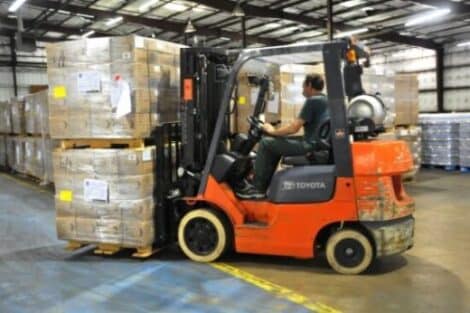Although some products are subject to price increases, dealing with inflation during restocking inventory is unavoidable. Regardless of what you sell, it’s critical to keep track of inventory valuation over time. Thus, how should a company keep track of inventory value fluctuations throughout the present moment? Manufacturers, merchants, and wholesalers generally maintain physical inventory, and their inventory flow and flexibility might just be the biggest investment account on the financial statements. Nevertheless, one of the most prevalent strategies for ensuring accurate inventory records is FIFO (first-in, first-out), which assumes that the oldest inventory was sold first and the value is computed accordingly. Also, the cost of goods sold (COGS), profit, and the value of ending inventory are all calculated using the inventory valuation method. This piece you’re about to read will answer all your questions regarding the Fifo method and its inventory costing as well as the LIFO method.
Have fun reading….
What Is Fifo Method
First In, First Out (FIFO) is an asset management and valuation method that is based on the assumption that products are sold or used in the same order as they are purchased.
The cost flow assumption of the first-in, first-out (FIFO) method of inventory valuation is that the first things acquired are also the first products sold. Basically, it is one of the most frequent methods for estimating the value of inventory on hand at the conclusion of an accounting period and the cost of items sold during the period. This strategy assumes that inventory that was acquired or made initially sells first, leaving newer inventory unsold. As a result, the cost of older inventory goes to the cost of goods sold, while the cost of newer inventory goes to ending inventory.
This assumption is regarded as the most theoretically sound and comprehensive inventory method of valuation in most firms since it closely matches the real flow of goods. Because selling off the oldest goods first decreases the risk of inventory obsolescence, the FIFO principle is a sensible one for a corporation to adopt.
Understanding How the Fifo Method Works
Generally, businesses adopt the Fifo method for cost flow assumptions. When products proceed to further development stages and final inventory items are sold, the accompanying expenses must be recognized as expenses in production. The cost of the inventory you purchased first is assumed to be recognized first under the FIFO method.
You are accountable for handling COGS at the conclusion of the accounting period or fiscal year. This, however, is because e-commerce inventory is treated as an investment. As a result, the ending inventory value will always affect your balance sheets and inventory write-offs. However, more current merchandise tends to cost more than older stuff due to inflation. And because the lower-value commodities are sold first with the FIFO method, the ending inventory has a higher value.
Furthermore, any inventory remaining at the conclusion of the fiscal year has no bearing on the cost of goods sold (COGS). Nevertheless, it’s crucial to remember that FIFO is a method of inventory accounting that uses a simple formula to determine the value of ending inventory.
In addition, if you sell commodities with a limited life span, are perishable, or are prone to becoming obsolete fast, the FIFO method offers the benefits of proper inventory management as well as an easy approach for estimating ending inventory value.
Hence, you may track and control quality while also avoiding the danger of high holding costs for maintaining inventory that is outmoded or no longer marketable. This is by calculating inventory value that tracks the regular flow of goods throughout your distribution chain.
While it might be the simplest and most widely used valuation approach, the FIFO method has the disadvantage of causing considerable disparities when COGS climbs dramatically.
FIFO Method Example
Assume Company A runs a fabric store. For instance, Company A is now analyzing inventory activity for a new product at a given time. Hence, Company A reported beginning inventories of 100 units at $5/unit.
At the same time, the company also makes further purchases:
- 100 units at $7/unit
- 100 units at $8/unit
- And, 100 units @ $9/unit
In the end, assuming the Company sold 250 units of this product, the below table shows what the order of cost expenses would look like:
| Unit Purchased | Cost Per Unit | Totals | |
| Beginning Inventories | 100 | $5 | $500 |
| Purchases | 100 | $7 | $700 |
| Purchases | 100 | $8 | $800 |
| Purchases | 100 | $9 | $900 |
As the above illustration shows, company A sold 250 products out of its stocks of 400. However, since we are using the Fifo method, the beginning inventories matter and will determine Company A cost of goods sold (COGS). While it moves its way downwards till it fulfills the number of units sold requirements. Company A’s COGS calculation is as follows:
- 100 units @ $5/unit = $500
- 100 units @ $7/unit = $700
- 50 units @ $8/unit = $400
- COGS Total: $1,600.
Company A’s total cost of goods sold for the sale of 250 units would be $1,600.
Meanwhile, the remaining unsold 150 products will stand on the balance sheet as inventory, which is at the cost of $1,300.
- 50 units @ $8/unit = $400 in inventory.
- 100 units @ $9/unit = $900 in inventory.
Hence, Company A can use the cost of goods sold to help determine its profit.
The FIFO Method for Inventory
The FIFO method for inventory is an inventory valuation approach that assumes you sell your oldest goods first. Generally, it’s so popular. This, however, is because it closely resembles how things function in real life, such as when your local shop sells its oldest ingredients first to preserve the inventory fresher.
Basically, your cost of goods sold (COGS) will be computed using the unit cost of the oldest inventory first when you employ the Fifo method. The most recent inventory you acquire will thereafter determine your ending inventory’s worth.
Effects of the FIFO Inventory Valuation Method on Financial Statements
While there are numerous valuation methods, each with its purposes and impact. Now is the time to think about how FIFO affects a company’s financial statements.
#1. Inventory Valuations That Are More Accurate
Generally, when utilizing the Fifo method, the balance sheet gives a better representation of inventory market value. The inventory indicates the most recent manufacturing or acquisition costs, and hence the balance sheet reflects the approximate current market worth.
Imagine a corporation that has two ATVs in its initial inventory, each costing $45,000 each. Furthermore, the corporation goes on to purchase another ATV for $80,000. Whenever the corporation makes a new sale of one ATV, it will deduct as expenses the cost of the older ATV, which is $45,000.
As a result, compared to other inventory valuation methodologies, this will provide top-class-quality information on the balance sheet. Basically, the price of the newer ATV is more accurate in terms of the current market worth
#2. Revenue and Expense Do Not Match.
There is poor synchronization on the financial statements because Fifo expenditures are the oldest costs from the beginning of inventory. The income from inventory sales is synchronized with an out-of-date cost.
Using the same scenario as before, but with two ATVs costing $45,000 each and a new ATV costing $80,000. A $45,000 loss would arise from selling one ATV (FIFO method). Hence, the revenue generated from the sale is matched with an older, outdated cost, resulting in poor revenue statement matching.
The FIFO Method of Inventory Costing
Inventory method costing computation is an important aspect of preparing your business tax return. You can deduct the cost of the things you purchase to resell, like other valid business expenses from your business income to lower your taxes.
You have a beginning inventory of products in various states of completion or ready to sell at the start of the year. Throughout the year, you purchase more merchandise and sell part of it. You should keep a record of the cost of the inventory that you distribute as a business expense that you subtract from your sales at the end of the year. The cost of goods sold is the term for this calculation.
In addition, the IRS has put together some guidelines for calculating the cost of products sold. However, one approach to using FIFO in calculating the cost of goods sold for your business tax return is FIFO.
FIFO and LIFO Method of Inventory- The Differences
Last in, first-out (LIFO method) means that products acquired or manufactured last are sold first (and the recently purchased inventory will be shipped out to customers before the oldest or beginning of inventory). Basically, it is an alternative valuation approach that businesses or companies use lawfully in the United States.
FIFO, on the other hand, is the most widely used inventory valuation method in most countries or regions. While the IFRS, the International Financial Reporting Standards Foundation (IRFS) is legislation supporting it.
Accordingly, the original COGS will be recorded in the income statement of businesses that employ the FIFO approach. While the most recent inventory costs are recorded first when using the LIFO method.
Likewise, when employing the LIFO method, businesses will pay less in taxes if COGS are higher and profits are lower. Obviously, the IRA is against the LIFO method because it lowers income tax.
For certain businesses, though, it makes more sense. As a result, the IRS allows you to employ the LIFO method as long as you file a Form 970 application.
When compared to the LIFO method, FIFO happens to be more clear and more accurate. While it also has a better gross profit margin than LIFO.
When Might the FIFO Technique Be Appropriate?
It is a technique used in the computation of the cost of goods sold to support cost flow assumptions. The FIFO approach is predicated on the idea that the oldest items in an organization’s inventory have already been sold. The computation is based on the prices paid for those earliest products.
Why Is FIFO to Be Used?
Using FIFO, it is simple to assign costs to inventories by using the most recent purchases. Businesses that offer perishable goods should use FIFO because, even though product movement is not required, it will provide you with the most accurate estimate of your inventory and sales profit.
Conclusion
Generally, your inventory, which comprises items, parts, and supplies, is a great asset for companies or businesses. While producing, purchasing, storing, as well as delivering inventory are all significant corporate expenses. Hence, you’ll need a mechanism to identify and value the goods in your inventory before you can value them.
In addition, inventory valuation is critical for business tax purposes since it serves as the foundation for the cost of goods sold calculations (COGS). Besides, by ensuring that COGS includes all inventory costs, you may maximize your deductions while lowering your tax burden.
FIFO methods of inventory valuation, in comparison to the LIFO inventory system, offer an accurate balance sheet valuation of inventory. On the other hand, it has a poor fit or matching of revenue and expenses.
FAQs
Why is Inventory Important?
One rationale for inventory valuation is to determine its worth for inventory finance. Another incentive to value inventory is that inventory expenditures reflect the cost of goods sold, which lowers taxable income.
What Are the Benefits of FIFO over other inventory valuation method?
The important benefit of FIFO is that it is the most extensive in-use approach to inventory valuation worldwide. It’s also the most precise means of aligning estimated cost flow with real cost flow, giving firms a more accurate picture of inventory costs. It also mitigates the effects of inflation.
What Are the FIFO Disadvantages?
Due to the bigger disparity between expenses and profits, using the FIFO technique, a corporation may have to pay more income tax (than with LIFO). Businesses might also have to use the FIFO method with caution to avoid profit misrepresentation. This, however, usually happens when product costs rise and firms are using the new numbers rather than the true cost in the cost of goods calculation.
What Are Some Alternative Inventory Valuation Techniques?
LIFO (Last In, First Out) is the polar opposite of FIFO, with the last item purchased or obtained being the first item out. Alongside FIFO and LIFO, the average cost inventory method also gives the exact same cost to each item, resulting in net income and ending inventory balances. Furthermore, when you can identify all components traceable to a final product, it means specific inventory tracing is in place
Related Articles
- COST OF GOODS MANUFACTURED: Formula, Schedule, & How to Calculate Guide
- Business Valuation: All you need to know [Detailed Guide]
- How To Calculate Average Inventory- A complete Step-by-Step Guide
- Stock Valuation: Overview, & Effective Valuation Methods
- CONTRACTIONARY MONETARY POLICY: Definition, Examples, and Effects






